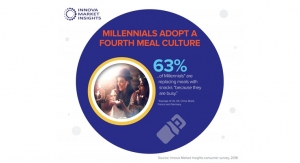08.13.19
More than half of U.S. consumers purchase yogurt while grocery shopping, according to Innova Market Insights, but their habits appear to be changing.
Convenience is increasingly important, for example, with 17% of consumers in 2018 naming this attribute as a significant factor in their purchasing decision, which is more than twice as many as in the previous year.
This can be explained by a shift in eating occasions, as evidenced by recent data. The majority of people still eat yogurt for breakfast but it’s becoming a snack or dessert option as well.
“These shifts highlight the importance of ongoing innovation in this marketplace,” said Lu Ann Williams, director of innovation at Innova Market Insights. “Convenient formats are now important for many consumers, while the rise of dinner usage suggests interest in more indulgent, dessert style yogurts.”
In addition to convenience, health is a key driver of yogurt purchases. The percentage of consumers who cited health as a significant choice factor has dropped in recent years, but most yogurts now occupy at least some kind of health platform, so healthiness is increasingly accepted as standard.
For example, in 2018, 64% of all new yogurts made digestive or gut health claims, while 58% were low in fat. With a growing focus on sugar reduction, low sugar and no added sugar claims increased their share of yogurt launches from just 3% in 2014 to 21% in 2018.
Convenience is increasingly important, for example, with 17% of consumers in 2018 naming this attribute as a significant factor in their purchasing decision, which is more than twice as many as in the previous year.
This can be explained by a shift in eating occasions, as evidenced by recent data. The majority of people still eat yogurt for breakfast but it’s becoming a snack or dessert option as well.
“These shifts highlight the importance of ongoing innovation in this marketplace,” said Lu Ann Williams, director of innovation at Innova Market Insights. “Convenient formats are now important for many consumers, while the rise of dinner usage suggests interest in more indulgent, dessert style yogurts.”
In addition to convenience, health is a key driver of yogurt purchases. The percentage of consumers who cited health as a significant choice factor has dropped in recent years, but most yogurts now occupy at least some kind of health platform, so healthiness is increasingly accepted as standard.
For example, in 2018, 64% of all new yogurts made digestive or gut health claims, while 58% were low in fat. With a growing focus on sugar reduction, low sugar and no added sugar claims increased their share of yogurt launches from just 3% in 2014 to 21% in 2018.
























